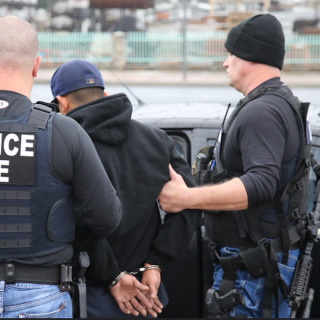Professionals who work on the front lines of protecting the rights of people held in Ohio detention centers, jails, and prisons are calling for swift action to prevent COVID-19 outbreaks.
“U.S. immigration detention facilities are the perfect arrangement to cause an explosion of COVID-19 cases,” said Dr. Laura Chambers-Kersh, a family physician based in Beavercreek. Detainees live in “cramped, overcrowded quarters with limited access to basic preventive measures like soap and water, hand sanitizer, and the ability to social distance,” she said in a March 24 press conference.
Dr. Chambers-Kersh treated patients in Liberia during the 2015 Ebola pandemic. In Ohio she has treated immigrant patients for over 20 years, including asylum exams for patients housed in detention centers. “The mumps outbreak scene last year — when 900 cases were reported in migrants being held in detention centers — is evidence of how quickly infections can spread,” she said. “The medical care available in DHS custody cannot meet the needs of patients should there be an outbreak. In the last few years, we’ve already seen multiple detainees fail to receive proper medical care, sometimes to the point of death, such as the three children who died of influenza in 2018.”
If COVID-19 breaks out in a detention center, many patients would require transfer to nearby hospitals, adding to the burden of surrounding healthcare systems that are already overwhelmed, Chambers-Kersh said. “From a medical perspective, the best course of action to prevent rapid spread of COVID-19 in detention centers is to reduce the networks of transmission by reducing the number of people who could carry, transmit, and suffer from the virus. Failure to release detainees in the midst of the current pandemic has a high probability of leading to suffering and death in a population that poses no danger to the general community.”
More than 3,000 medical professionals have signed an open letter urging U.S. Immigration and Customs Enforcement (ICE) officials to alleviate overcrowding in detention facilities by releasing detainees “while their legal cases are being processed to avoid preventable deaths and mitigate the harm from a COVID-19 outbreak.”
New Jersey has already begun to release up to 1,000 inmates who have been serving time county jails for probation violations and other low-level offenses. Cleveland officials have released hundreds of nonviolent inmates from the Cuyahoga County Corrections Center and ordered police to issue citations instead of making arrests.
Yvonka Hall, Executive Director of the Northeast Ohio Black Health Coalition, wants to see this policy increased and extended across Ohio. “We need to release nonviolent offenders,” she said. “We need to make sure that we're doing what is morally right within this context.”
“There are a lot of nonviolent offenders who are in county jails because they simply can’t post bail,” said Chrissy Stonebraker-Martinez, co-director of the InterReligious Task Force on Central America and Colombia.
“The Ohio Supreme Court issued a very weak sort of suggestion that people look at reducing sentences and things like that,” said Lynn Tramonte, Director of Ohio Immigrant Alliance. “But we need much more leadership from the state of Ohio on this.”
Ohio Department of Health Director Amy Acton could provide that leadership, said Cincinnati immigration attorney Nazly Mamedova. “With the election issue, we saw the power Amy Action has. If she was able to postpone the election, she should be able to order the release of nonviolent inmates and ICE detainees.”
The Ohio Immigrant Alliance has issued a statement calling on officials to drastically reduce the number of incarcerated and detained people; suspend deportations and immigration arrests, close the Cleveland Immigration Court; and ensure that inmates have access to free soap, hand sanitizer, health care, and phone and video calls. Individuals and organizations can sign on to the statement here.



